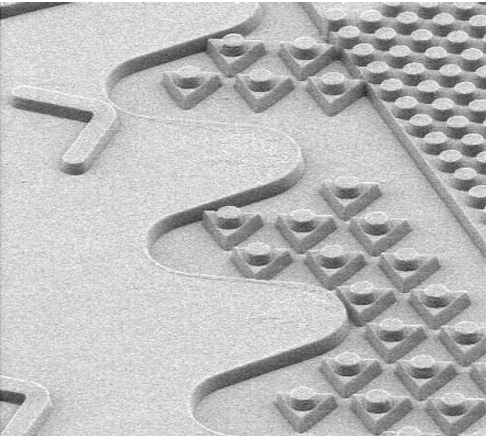


 النبات
النبات
 الحيوان
الحيوان
 الأحياء المجهرية
الأحياء المجهرية
 علم الأمراض
علم الأمراض
 التقانة الإحيائية
التقانة الإحيائية
 التقنية الحيوية المكروبية
التقنية الحيوية المكروبية
 التقنية الحياتية النانوية
التقنية الحياتية النانوية
 علم الأجنة
علم الأجنة
 الأحياء الجزيئي
الأحياء الجزيئي
 علم وظائف الأعضاء
علم وظائف الأعضاء
 الغدد
الغدد
 المضادات الحيوية
المضادات الحيوية|
Read More
Date: 2025-02-06
Date: 2025-01-25
|
The most basic fluidic structures to build microfluidic devices are microchannels. These channels provide the fluidic interconnection network between the fluidic elements of the device, but may have additional functions, like the channels in capillary electrophoresis and other separation techniques. Various shapes for the channel cross-section are used, including rectangular, v-shaped, and round. The shape of the cross-section may be determined by the fabrication method; a review is provided in Ref. . In many cases, the upper half of the channel contour is flat due to the sealing of the channels by a flat cover. Interesting exceptions to this are silicon nitride channels with a round cross-section buried underneath the surface of a silicon substrate , or round PDMS channels.
ratio of the structure, which is defined as the ratio of depth to width in the case of a channel. High-aspect ratio channels have a high surface to volume ratio and consume less floor space on the microfluidic chip. Channel widths commonly vary between the milli meter to the micrometer range; aspect ratios up to 10 are used. One microfluidic device may carry channels of different widths and aspect ratios, for different purposes. For example, auxiliary channels are used in capillary devices, with a much smaller diameter than the fluid channels, to allow the air to exit from the device when it is filled with fluid by capillary forces.
Other important structures are reaction/detection chambers, and sample and waste reservoirs. These are larger, well-type structures, with dimensions often in the millimeter range, designed to hold the correct amount of fluid.
In the case of reaction chambers, it is often advantageous to generate a high surface to volume ratio. This can be achieved by using auxiliary structures (Figure1), by folding up a channel in a meander-like form, or by using a porous, nanostructured surface .

fig1. Scanning electron micro graph of auxiliary structures in a mi crofluidic chamber. These are designed to generate a large surface to volume ratio. (Courtesy STEAG microParts.)
One special, but important, case of microreaction chambers is that of microcompartments used in array-type microfluidic devices for parallel processing, such as DNA chips and nanotiter plates. These are designed to hold fluid volumes in the order of 10 nL to several hundreds of nL. In the most simple case, these compartments will be not a spatial microstructure at all, but a spot on a flat surface carrying immobilized reagents, with good wetting properties, and separated from neighboring spots by hydrophobic regions. In the case of nanotiterplates, the bottom of the compartments may be a thin mem brane, so that optical detection techniques can be applied through the membrane from the bottom side. For applications in combinatorial chemistry, where the possibility to wash and filter reagents is essential, these membranes may be patterned to contain pores in the nanometer or micrometer range.
Active and passive valves are needed to block the fluid flow in a controlled manner. Valves may be used as discrete devices, or integrated into the fluidic chip. Technically, cantilever and diaphragm-type valves are used; reviews are provided in Refs. . Fluidic diodes, which do not have any moving parts, are also used; these do not block the flow in one direction completely, but provide a large difference in impedance. Moreover, they are easy to integrate into the system.
Propagation of fluids in the chip is achieved by the use of micropumps which, as in the case of valves, may be either external or integrated into the microfluidic device. Technically, most micropumps are membrane-actuated pumps, using pneumatic, thermopneumatic, piezoelectric, electrostatic, bimetallic, or shape-memory effects for actuation. Some electric field-actuated pumps (electrohydrodynamic and electroosmotic) and micro gear pumps are also available; an overview is provided in Refs.
As flow in microfluidic devices is strictly laminar, mixing must be initiated using a specially designed element, a micromixer. Most micromixers are static mixers, which are exclusively based on the diffusion of the liquids to be mixed. Diffusion requires time, and this must be provided in the microsystem by using long, parallel flow regions and having large interfaces between the liquids to be mixed. This is often achieved by multiple splitting of the fluid strand, and recombining. Methods to go beyond laminar mixing include the use of microbeads . and chaotic mixing using relief structures at the channel bot tom. A review of mixers is provided in Ref. .
Other fluidic structures in microfluidic devices include sensors for physical parameters such as pressure, temperature, and flow, as well as chemical sensors and biosensors. Such elements are found in Lab-on-a-Chip devices, while in single-use disposable fluidic devices these more expensive systems will not be part of the fluidic device.



|
|
|
|
دخلت غرفة فنسيت ماذا تريد من داخلها.. خبير يفسر الحالة
|
|
|
|
|
|
|
ثورة طبية.. ابتكار أصغر جهاز لتنظيم ضربات القلب في العالم
|
|
|
|
|
|
|
قسم شؤون المعارف ووفد من جامعة البصرة يبحثان سبل تعزيز التعاون المشترك
|
|
|